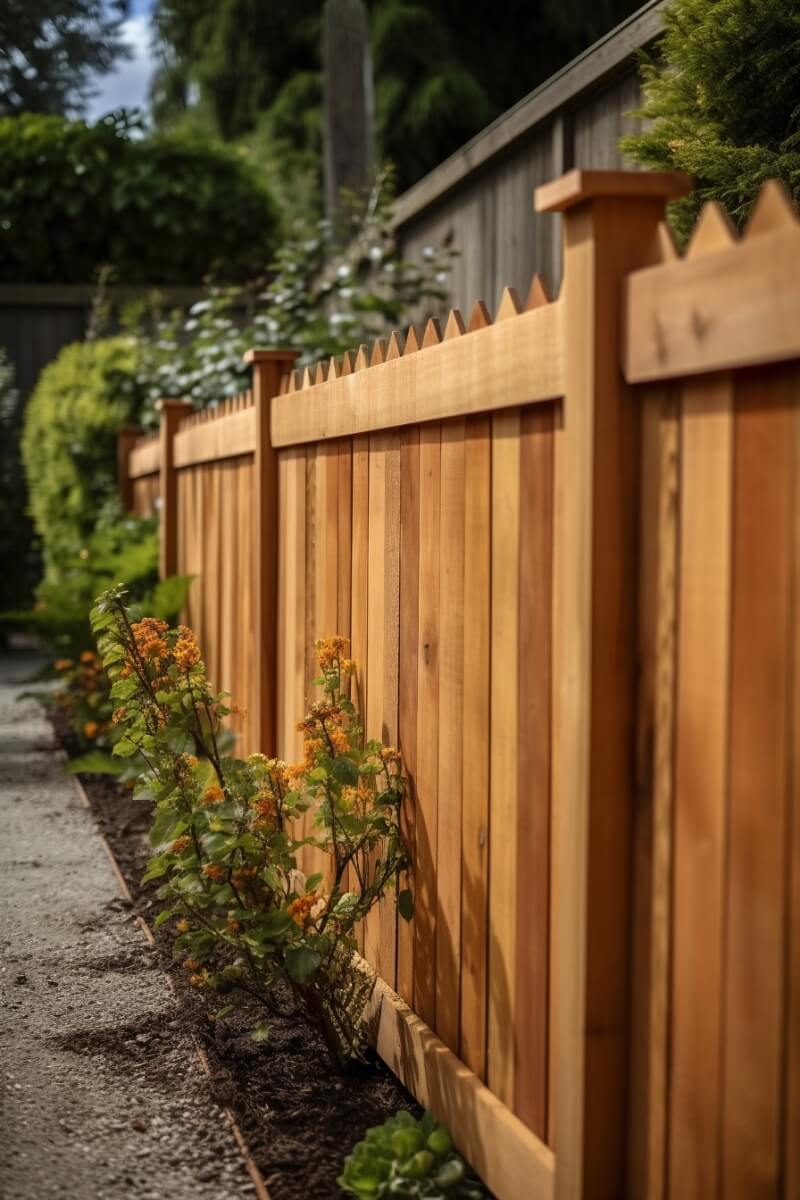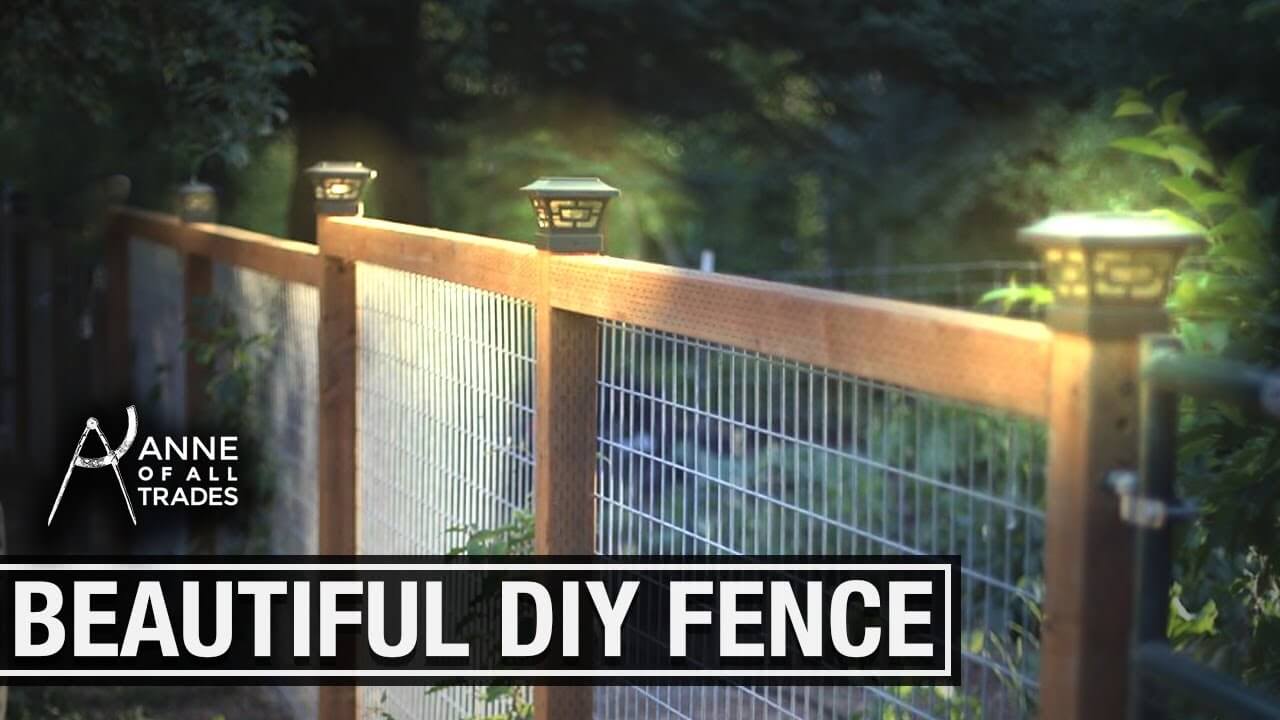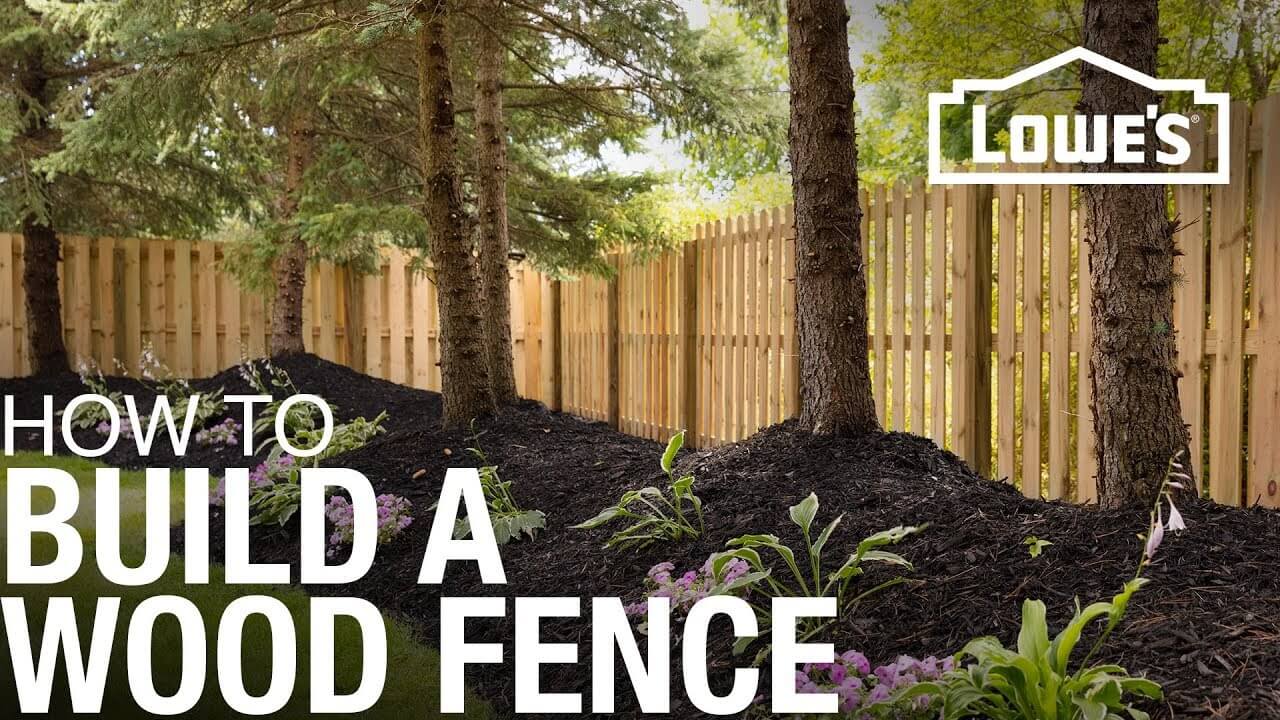Best Wood for Wooden Fence: A Homeowners Guide
When choosing wood for your fence, do not forget to consider resistance to local weather and insects in terms of durability. The best wood for wooden fences includes cedar, redwood, cypress, Douglas fir, pine, ipe, balau, maple, composite wood and acacia.
Choosing the best wood for a wooden fence is crucial for creating a long-lasting, durable, and attractive barrier around your property. As an expert in outdoor construction materials, I will guide you through the process of selecting the perfect wood type based on factors like durability, maintenance, and local climate.
Understanding the importance of this decision can save you time, money, and effort in the long run. In fact, a well-chosen wood type can extend the lifespan of your fence by up to 30 years! So let’s get to it.
Best Wood for Outdoor Fences
1 | Cedar
As a professional carpenter, I can attest to the popularity of cedar for wooden fences. Cedar is a close-grained softwood, known for its attractive knots and natural rot-resistance. This makes it an ideal choice for budget-conscious homeowners, with costs ranging from $2 to $8 per six-foot picket.
The western red cedar, though it is a slightly more expensive wood, is also an excellent option. One of my favorite features of cedar is its pleasant aroma, which not only adds to its charm but also repels many insects, providing added protection for your fence.
| Characteristic | Cedar Wood for Garden Fences |
|---|---|
| Durability | Cedar wood is highly durable, lasting between 15-30 years if maintained |
| Hardness | Cedar is moderately soft, making it easier to work with but less dense |
| Rot Resistance | Cedar wood has natural oils that provide excellent resistance to rot |
| Insect Resistance | Cedar wood’s natural oils repel insects, reducing the risk of damage |
| Permeability | Low permeability, limiting water absorption and promoting longevity |
| Weight | Cedar is lightweight, making it easier to transport and install |
| Fence Style | Suitable for various styles, such as picket, privacy, and lattice top |
| Finish/Treatment | Staining, sealing, or natural weathering are common finishing options |
| Maintenance | Low maintenance; periodic cleaning, staining/sealing, and damage checks |
| Cost | Moderate cost, more affordable than redwood but pricier than pine |
| Sustainability | Cedar wood is a renewable resource and can be sourced sustainably |
| Harvesting Impact | Properly managed cedar forests minimize negative impacts on ecosystems |
| Carbon Footprint | Cedar has a relatively low carbon footprint compared to other materials |
Cedar: Mini-Summary & Ideal Fence Type
- Naturally Resistant: Cedar’s inherent oils offer rot and insect resistance, ensuring a long-lasting, low-maintenance fence.
- Versatile Styling: Cedar’s workability and aesthetics make it perfect for various fence styles, including picket, privacy, and lattice top.
- Sustainable Material: Sourced responsibly, cedar promotes environmental sustainability, boasts a lower carbon footprint, and minimizes harvesting impact.
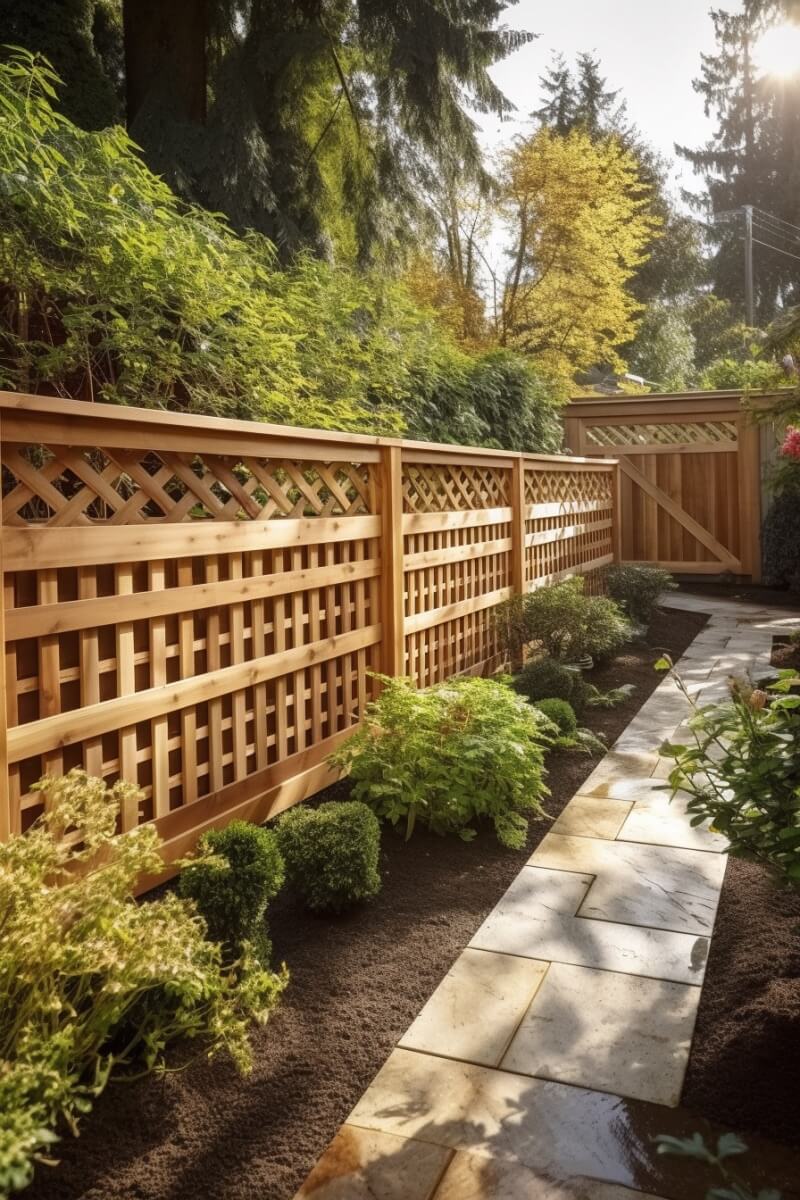
Pros
Cons
2 | Redwood
In my experience as a carpenter, redwood is another top choice for wooden fences, rivaling cedar in popularity. Its exceptional durability and weather resistance make it an excellent investment for homeowners. The unique, reddish-brown hue of redwood adds a touch of elegance to any fence, setting it apart from other wood types.
Furthermore, redwood has the added benefit of deterring insects, providing a natural defense against potential infestations. When considering fence materials, redwood stands out as a reliable and visually striking option.
| Characteristic | Redwood for Garden Fences |
|---|---|
| Durability | Redwood is highly durable, lasting over 25 years with proper maintenance |
| Hardness | Moderately hard, providing structural stability and resistance |
| Rot Resistance | Natural tannins make redwood resistant to rot and decay |
| Insect Resistance | Natural tannins repel insects, reducing potential damage |
| Permeability | Low permeability, limiting water absorption and promoting longevity |
| Weight | Moderate weight, offering a balance between stability and workability |
| Fence Style | Suitable for various styles, such as picket, privacy, and lattice top |
| Finish/Treatment | Staining or sealing optional, maintains color without frequent restaining |
| Maintenance | Low maintenance; periodic cleaning and damage checks |
| Cost | Expensive, $8 to $10 per picket; higher than cedar and pine |
| Sustainability | Popularity has left redwood endangered; sourcing may be difficult |
| Harvesting Impact | Responsible harvesting is crucial to minimize environmental damage |
| Carbon Footprint | Higher carbon footprint than cedar, but still relatively low |
Redwood: Mini-Summary & Ideal Fence Type
- Superior Durability: Redwood’s longevity, over 25 years with proper care, provides a strong, long-lasting fencing solution.
- Versatile Fence Styles: Redwood’s natural beauty and workability make it an ideal choice for picket, privacy, and lattice top fences.
- Eco-Conscious Sourcing: While redwood is endangered, responsible harvesting and management practices can minimize environmental impact and promote sustainability.
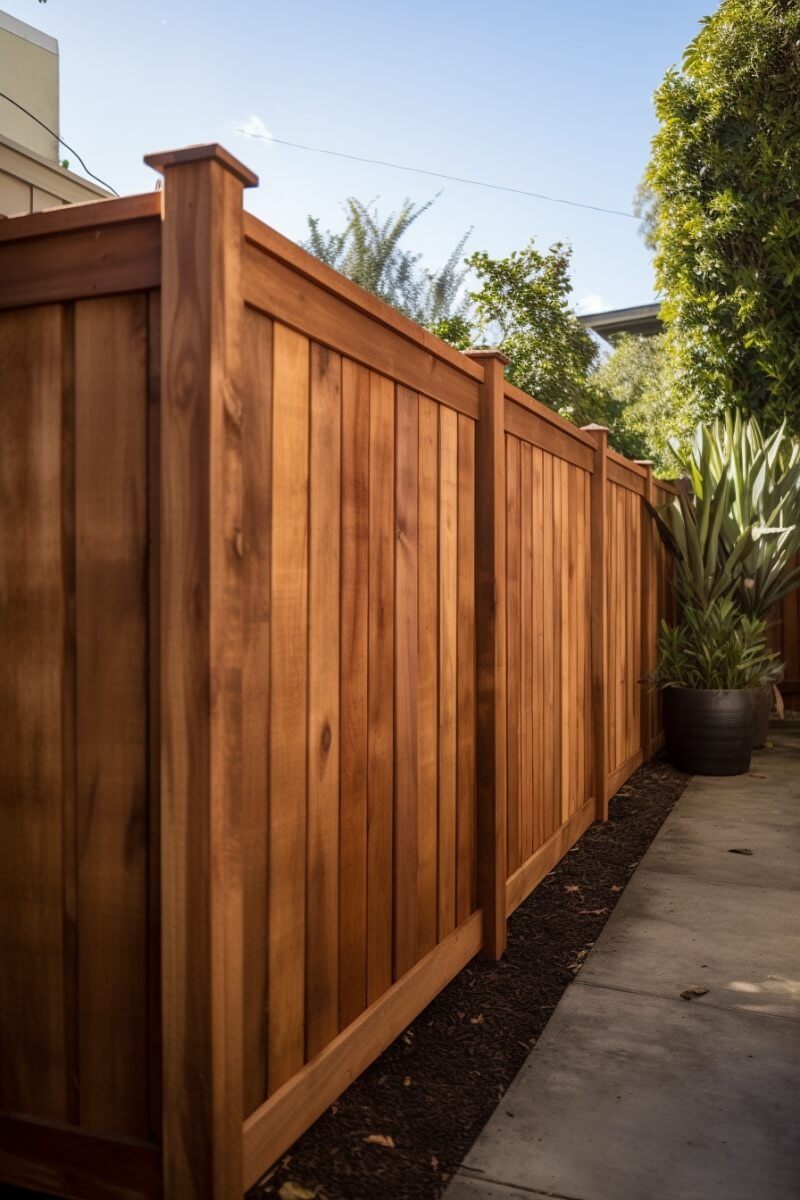
Pros
Cons
3 | Cypress
During my time as a carpenter, I’ve found cypress to be a great alternative to cedar for wooden fences. As a native southern softwood, it shares a similar price range and characteristics with fir wood, particularly Douglas fir. Cypress is a knotted wood, and its beautiful hues can enhance any fence’s appearance.
One of the best aspects of working with cypress is its ease of use – drilling, cutting, and nailing are a breeze. Additionally, cypress is insect-resistant due to a natural repelling substance called cypretine, which adds to its appeal as a fencing material.
| Characteristic | Cypress for Garden Fences |
|---|---|
| Durability | Cypress is durable, lasting 20-25 years with proper maintenance |
| Hardness | Moderately soft, providing workability and moderate resistance |
| Rot Resistance | Cypress has natural oils that make it resistant to rot and decay |
| Insect Resistance | Natural oils repel insects, reducing the risk of damage |
| Permeability | Low permeability, limiting water absorption and promoting longevity |
| Weight | Cypress is lightweight, making it easier to transport and install |
| Fence Style | Suitable for various styles, such as picket, privacy, and lattice top |
| Finish/Treatment | Staining or sealing optional, can weather naturally to a silver-gray hue |
| Maintenance | Low maintenance; periodic cleaning, staining/sealing, and damage checks |
| Cost | Moderate cost, similar to cedar but less expensive than redwood |
| Sustainability | Cypress is a renewable resource and can be sourced sustainably |
| Harvesting Impact | Properly managed cypress forests minimize negative impacts on ecosystems |
| Carbon Footprint | Cypress has a relatively low carbon footprint compared to other materials |
Cypress: Mini-Summary & Ideal Fence Type
- Durable and Resistant: Cypress lasts 20-25 years, featuring natural oils that resist rot, decay, and insect infestations.
- Adaptable Fence Styles: Cypress’s workability and aesthetics make it ideal for picket, privacy, and lattice top fences.
- Eco-Friendly Option: Sustainably sourced cypress offers a renewable, low-carbon alternative with minimized harvesting impact on ecosystems.
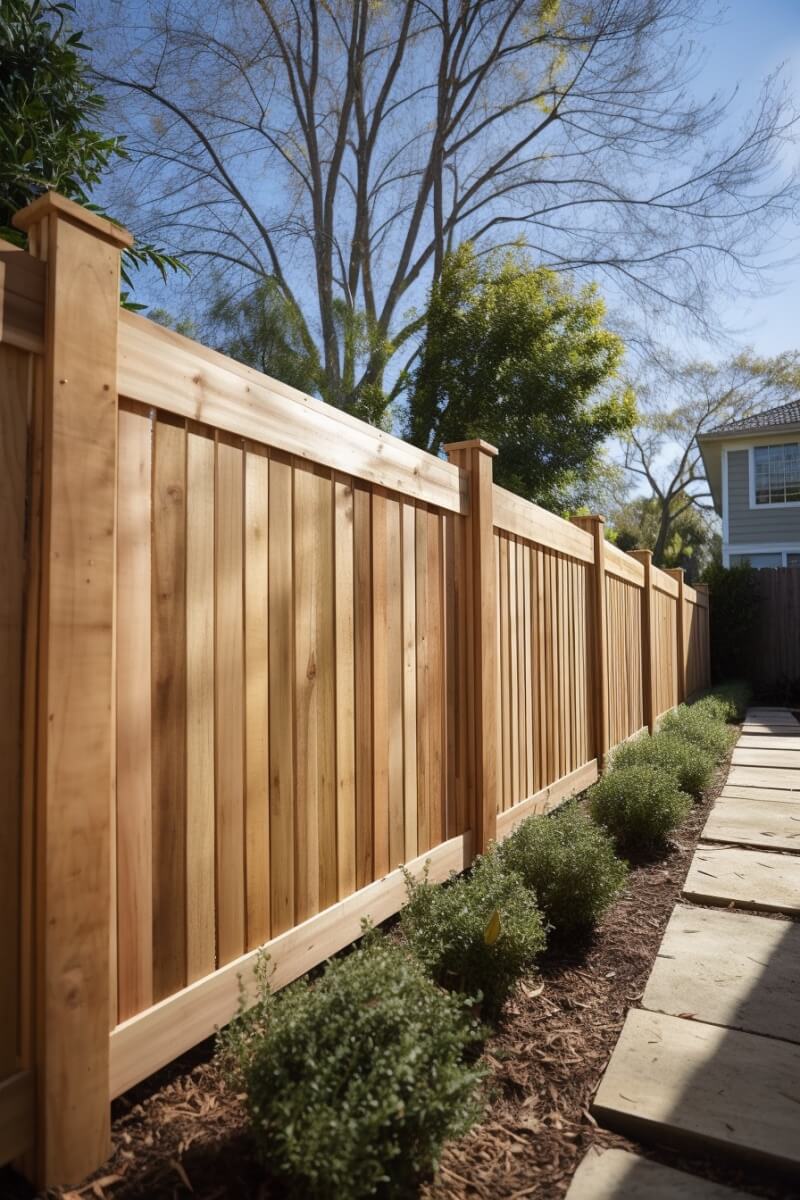
Pros
Cons
4 | Pine
In my experience, pine is a solid option for wood fencing due to its durability and workability. As a softwood, it’s easy to shape and install. According to the USDA Forest Service, matured pinewood has natural oils, making it rot-resistant.
However, for outdoor fencing, pressure treatment is necessary. Pressure treatment involves forcing chemical preservatives into the wood, significantly enhancing its resistance to weather, moisture, and insects, ensuring a longer-lasting fence.
| Characteristic | Pine for Garden Fences |
|---|---|
| Durability | Pine is moderately durable, lasting 10-15 years with proper maintenance |
| Hardness | Softwood, easy to work with but less resistant to impacts |
| Rot Resistance | Pine requires pressure-treatment for increased rot resistance |
| Insect Resistance | Pressure-treated pine provides resistance against insects |
| Permeability | Moderate permeability, treatment reduces water absorption |
| Weight | Pine is lightweight, making it easier to transport and install |
| Fence Style | Suitable for various styles, such as picket, privacy, and lattice top |
| Finish/Treatment | Staining, sealing, or paint is recommended to protect the wood |
| Maintenance | Regular maintenance; cleaning, staining/sealing, and damage checks |
| Cost | Inexpensive, most cost-effective among common fence wood types |
| Sustainability | Pine is a fast-growing, renewable resource with good sustainability |
| Harvesting Impact | Properly managed pine forests minimize negative impacts on ecosystems |
| Carbon Footprint | Pine has a relatively low carbon footprint compared to other materials |
Pine: Mini-Summary & Ideal Fence Type
- Budget-Friendly Choice: Pine offers a cost-effective solution, providing durability of 10-15 years with proper maintenance.
- Versatile Fence Styles: Pine’s ease of workability allows for various fence styles, such as picket, privacy, and lattice top.
- Sustainable Resource: Pine is a fast-growing, renewable resource, contributing to responsible forestry practices and eco-friendliness.
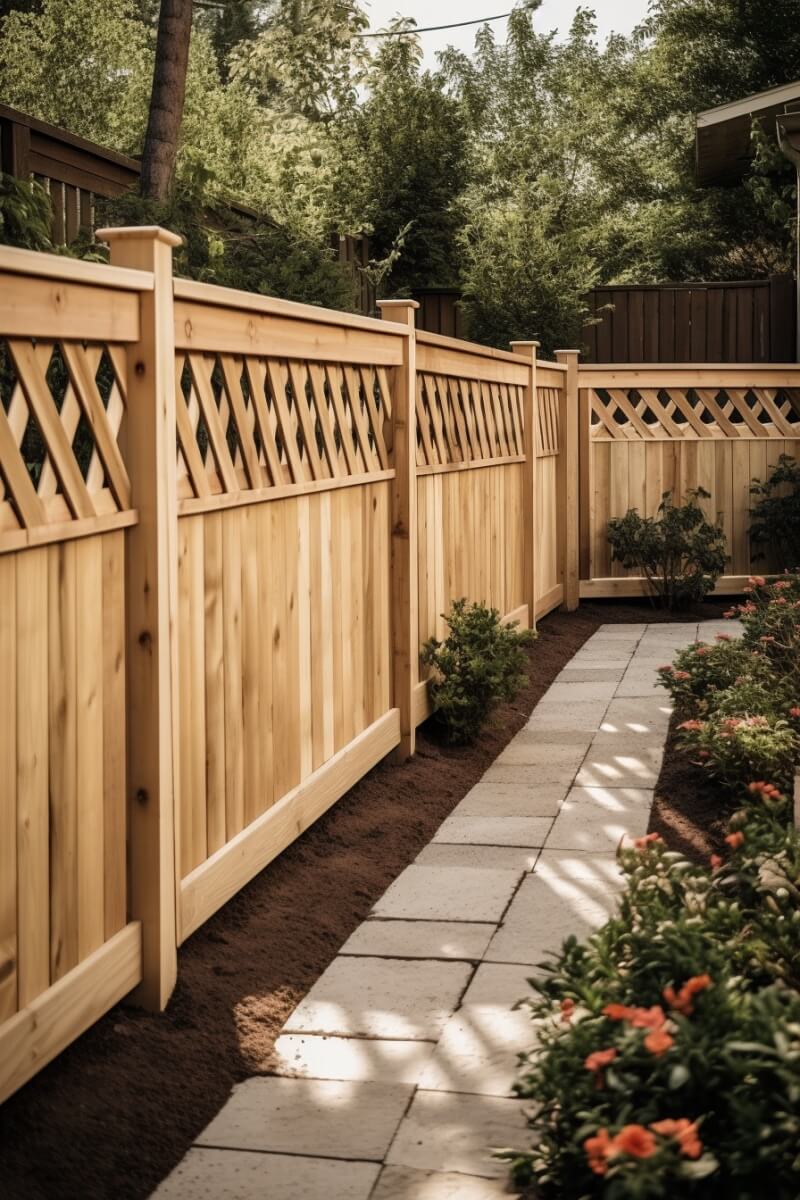
Pros
Cons
5 | Ipe
When seeking premium wood for fencing, I highly recommend ipe. Known for its exotic design and versatility, ipe, also called Brazilian walnut, originates from South America. According to Woodworking Network, it boasts exceptional strength and hardness, with a lifespan of over 75 years in outdoor conditions.
Ipe is fire-resistant with a Class A rating, water-resistant, and withstands harsh UV rays without fading. Its beautiful hue and durability make it an ideal choice for fences.
| Characteristic | Ipe for Garden Fences |
|---|---|
| Durability | Ipe is extremely durable, lasting up to 50 years with proper maintenance |
| Hardness | Very hard and dense, offering excellent structural stability |
| Rot Resistance | Ipe is highly resistant to rot and decay due to its dense structure |
| Insect Resistance | Ipe’s density and natural oils provide strong resistance to insects |
| Permeability | Very low permeability, limiting water absorption and promoting longevity |
| Weight | Ipe is heavy, making transportation and installation more challenging |
| Fence Style | Suitable for various styles, such as picket, privacy, and lattice top |
| Finish/Treatment | Staining or sealing optional, Ipe can be left to weather naturally |
| Maintenance | Low maintenance; periodic cleaning and damage checks |
| Cost | Expensive, one of the priciest wood options for fences |
| Sustainability | Ipe’s slow growth rate raises concerns about sustainability |
| Harvesting Impact | Responsible harvesting is crucial to minimize environmental damage |
| Carbon Footprint | Ipe has a higher carbon footprint due to transportation requirements |
Ipe: Mini-Summary & Ideal Fence Type
- Exceptional Durability: Ipe boasts an impressive lifespan of up to 50 years, offering unparalleled strength and longevity.
- Premium Fence Styles: Ipe’s natural beauty and density make it suitable for high-end picket, privacy, and lattice top fences.
- Eco-Conscious Harvesting: While Ipe’s slow growth raises sustainability concerns, responsible sourcing can minimize environmental impact.
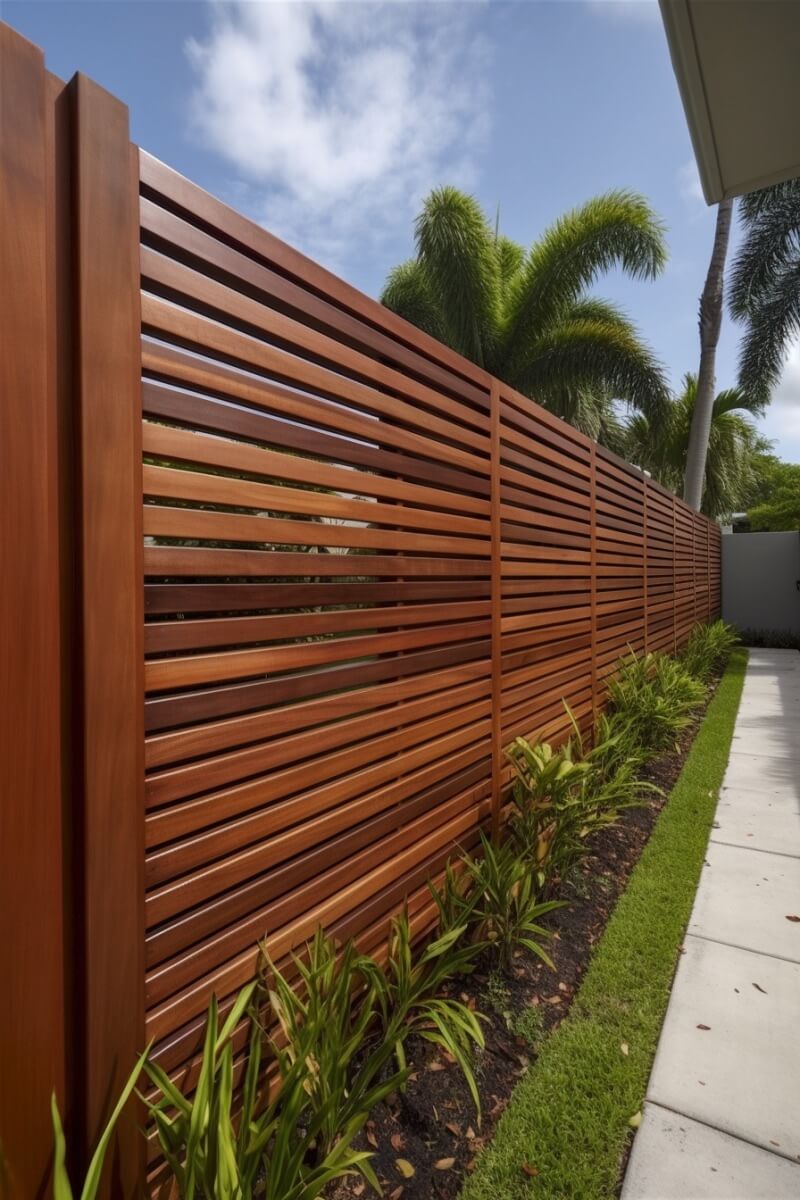
Pros
Cons
6 | Douglas Fir
Douglas fir is an abundant and structurally stable softwood that I often recommend for fence construction. Its hardiness and strength make it an appealing choice, and its lightweight nature allows for easy handling and modification. Wood Magazine highlights Douglas fir’s stunning aesthetics, which attract homeowners.
If you’re working with a tight budget, this wood is an excellent option. Additionally, Douglas fir is waterproof and highly weather-resistant, ensuring durability for your fence.
| Characteristic | Douglas Fir for Garden Fences |
|---|---|
| Durability | Douglas Fir is moderately durable, lasting 15-20 years with proper maintenance |
| Hardness | Moderately hard, providing structural stability and resistance |
| Rot Resistance | Requires pressure-treatment or sealing for increased rot resistance |
| Insect Resistance | Pressure-treated or sealed Douglas Fir offers resistance to insects |
| Permeability | Moderate permeability, treatment reduces water absorption |
| Weight | Douglas Fir is moderately heavy, providing stability |
| Fence Style | Suitable for various styles, such as picket, privacy, and lattice top |
| Finish/Treatment | Staining, sealing, or paint is recommended to protect the wood |
| Maintenance | Regular maintenance; cleaning, staining/sealing, and damage checks |
| Cost | Moderately priced, offering a cost-effective alternative to cedar |
| Sustainability | Douglas Fir is a renewable resource and can be sourced sustainably |
| Harvesting Impact | Properly managed Douglas Fir forests minimize negative impacts on ecosystems |
| Carbon Footprint | Douglas Fir has a relatively low carbon footprint compared to other materials |
Douglas Fir: Mini-Summary & Ideal Fence Type
- Affordable Durability: Douglas Fir offers a 15-20 year lifespan, providing a cost-effective alternative to cedar fencing.
- Customizable Fence Styles: The wood’s versatility allows for diverse fence styles, including board-on-board, shadowbox, and horizontal slat designs.
- Sustainably Sourced: With proper management, Douglas Fir forests yield a renewable, eco-friendly resource for fencing projects.
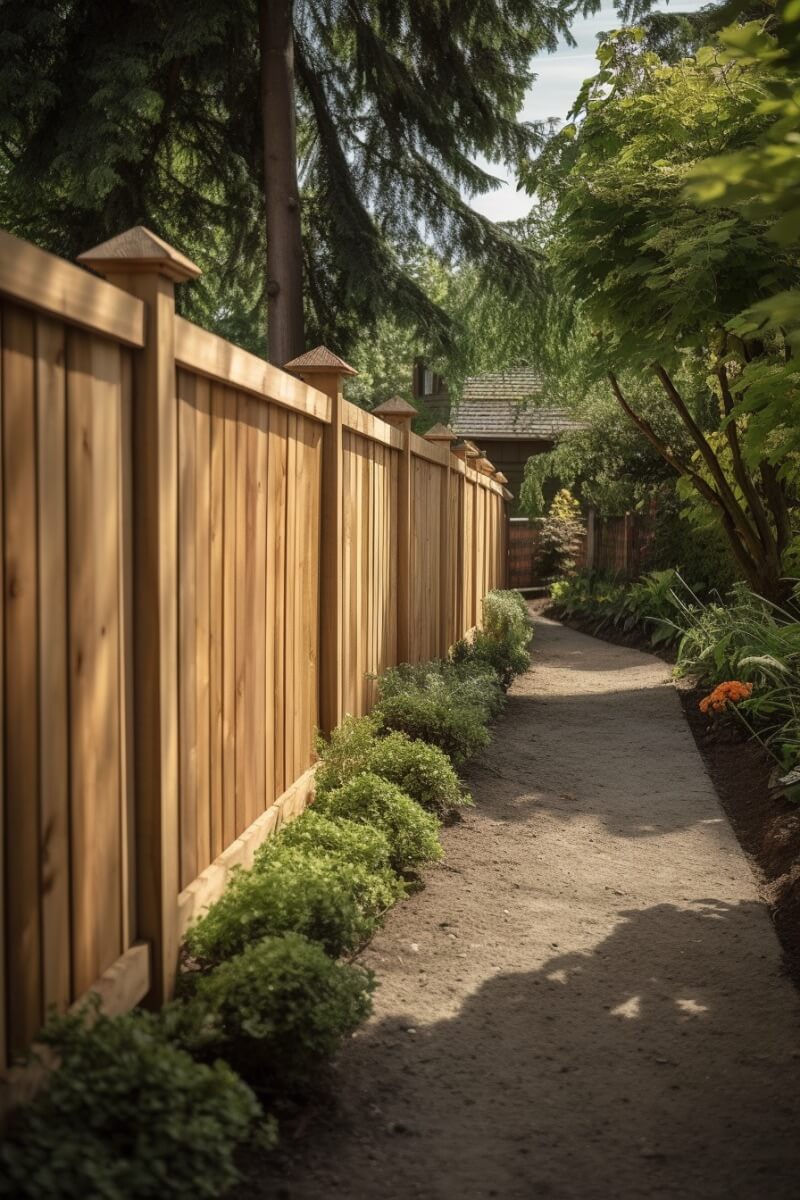
Pros
Cons
7 | Balau
Balau is a strong and affordable timber that I recommend for building fencing posts. Its robustness and durability make it an attractive option. Boasting distinctive grain patterns and dark hues, balau is also widely available.
As a sustainable wood choice, it offers an eco-friendly alternative. Due to its resistance to dents and scratches, balau is not only suitable for fencing but also ideal for decking and flooring projects.
| Characteristic | Balau for Garden Fences |
|---|---|
| Durability | Balau is highly durable, lasting up to 30 years with proper maintenance |
| Hardness | Hard and dense, providing excellent structural stability and resistance |
| Rot Resistance | Balau’s density and natural oils make it highly resistant to rot |
| Insect Resistance | Balau’s natural oils and density offer strong resistance to insects |
| Permeability | Low permeability, limiting water absorption and promoting longevity |
| Weight | Balau is heavy, making transportation and installation more challenging |
| Fence Style | Suitable for various styles, such as picket, privacy, and lattice top |
| Finish/Treatment | Staining or sealing optional, Balau can be left to weather naturally |
| Maintenance | Low maintenance; periodic cleaning and damage checks |
| Cost | Moderately expensive, offering a premium option at a lower price than Ipe |
| Sustainability | Balau’s growth rate allows for sustainable harvesting when managed responsibly |
| Harvesting Impact | Responsible harvesting practices are crucial to minimize environmental damage |
| Carbon Footprint | Balau has a higher carbon footprint due to transportation requirements |
Balau: Mini-Summary & Ideal Fence Type
- Impressive Durability: Balau offers a remarkable 30-year lifespan, ensuring long-lasting, reliable fencing solutions.
- Innovative Fence Styles: Balau’s unique properties inspire diverse fence designs, such as horizontal slat, post and rail, or ornamental patterns.
- Mindful Sourcing: While Balau has a higher carbon footprint, responsible harvesting practices help minimize environmental impacts.
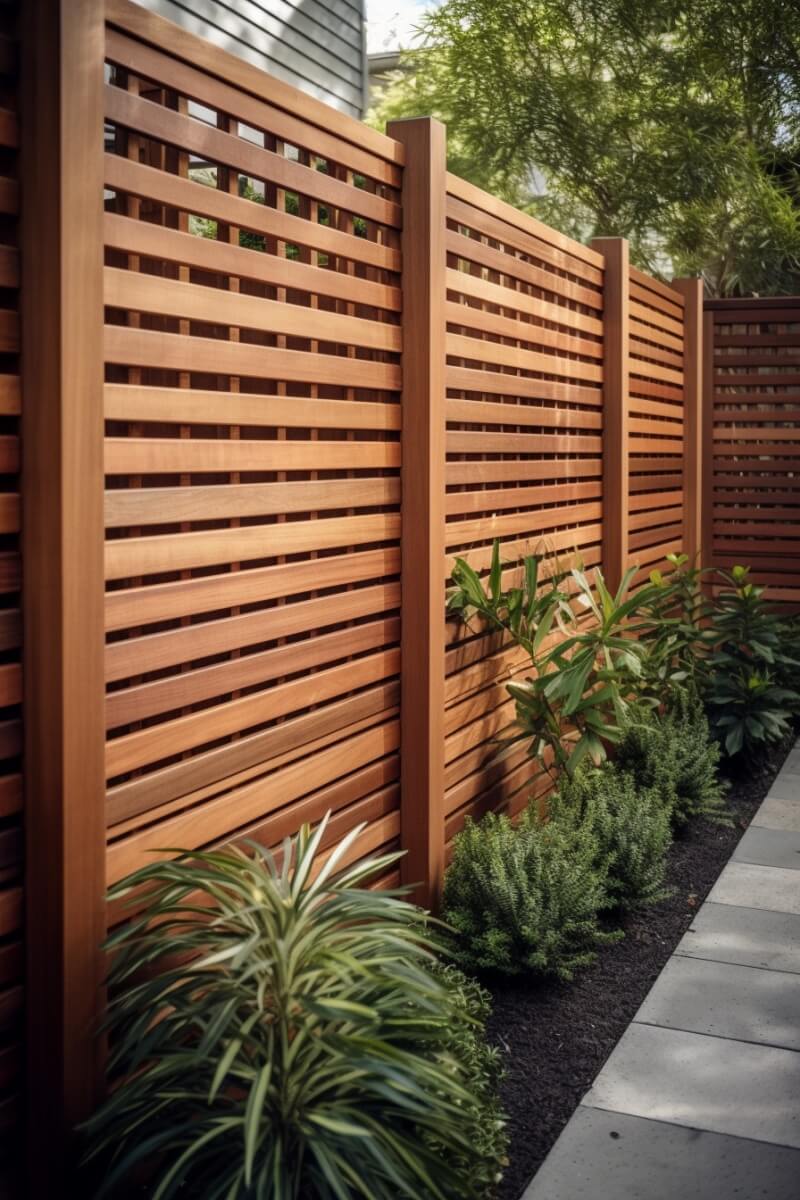
Pros
Cons
8 | Maple
Maple is a staple material in the US woodworking industry, and I highly recommend it for fencing projects. This hardwood is easily available, durable, and strong. Its white color makes it a preferred choice for finishing, and if you’re deadset on building a picket fence, this is the wood for you.
Furthermore, maple’s affordability makes it an attractive option for many homeowners. Maple is an excellent choice for wooden fences, especially as fence rails, due to its combination of strength and aesthetic appeal.
| Characteristic | Maple for Garden Fences |
|---|---|
| Durability | Maple is moderately durable, lasting up to 15 years with proper maintenance |
| Hardness | Hardwood, offering good structural stability and resistance |
| Rot Resistance | Maple requires sealing or treatment for increased rot resistance |
| Insect Resistance | Treated or sealed Maple provides resistance against insects |
| Permeability | Moderate permeability, treatment reduces water absorption |
| Weight | Maple is moderately heavy, providing stability |
| Fence Style | Suitable for custom styles, such as ornamental, picket, and privacy |
| Finish/Treatment | Staining, sealing, or paint is recommended to protect the wood |
| Maintenance | Regular maintenance; cleaning, staining/sealing, and damage checks |
| Cost | Moderately priced, offering a unique aesthetic at an affordable cost |
| Sustainability | Maple is a renewable resource and can be sourced sustainably |
| Harvesting Impact | Properly managed Maple forests minimize negative impacts on ecosystems |
| Carbon Footprint | Maple has a relatively low carbon footprint compared to other materials |
Maple: Mini-Summary & Ideal Fence Type
- Distinctive Aesthetic: Maple’s unique grain patterns and color variations provide an eye-catching fencing option.
- Adaptable Fence Designs: Maple’s workability allows for tailored fence styles, such as curved top, decorative picket, and modern paneling.
- Sustainable Forestry: When sourced responsibly, Maple offers an eco-friendly choice for garden fences, supporting well-managed forests.
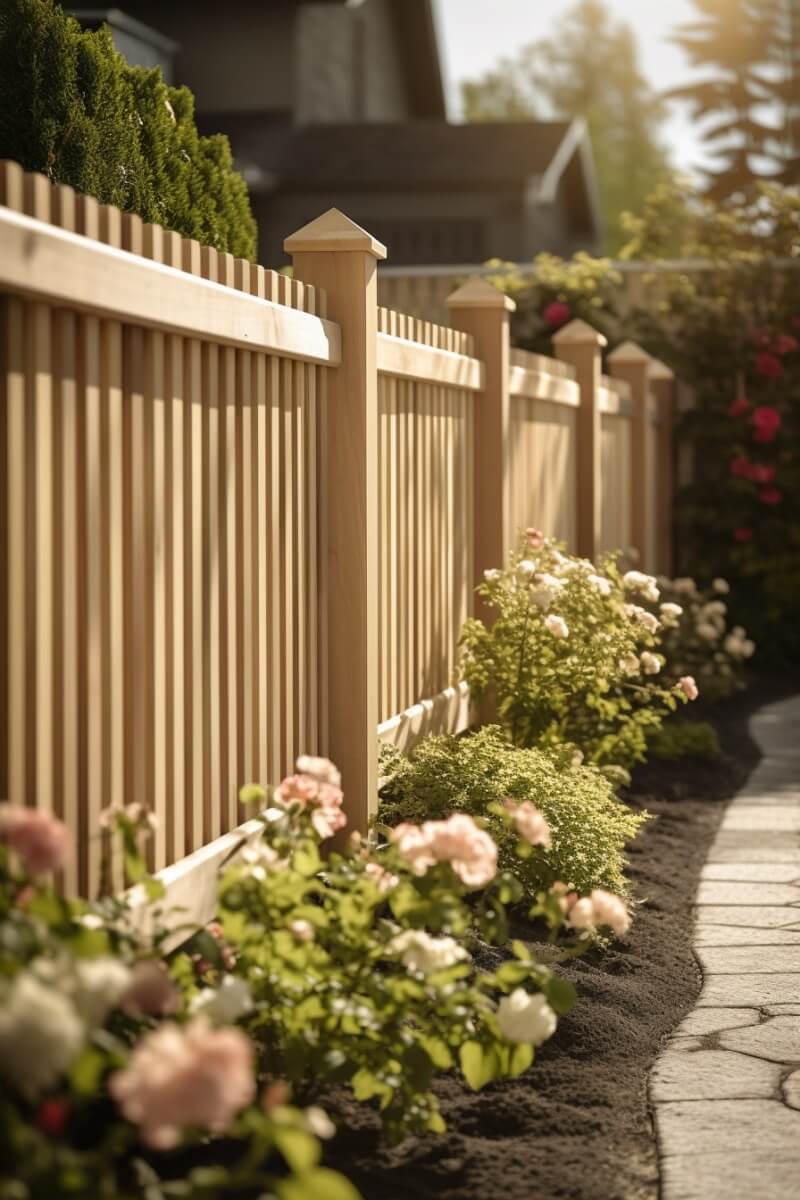
Pros
Cons
9 | Composite Wood
For those seeking an eco-friendly and sustainable option for wood fencing, I highly recommend composite wood. Although it’s not the cheapest choice, it is one of the sturdiest options available. Many manufacturers create composite wood by mixing recycled plastic with wood fibers, while others combine wood fibers with paper pulp and plastic.
This composition enhances its durability, weather resistance, and strength. Remarkably, composite wood can successfully imitate the appearance of various other types of wood, making it a versatile choice for fencing projects.
| Characteristic | Composite Wood for Garden Fences |
|---|---|
| Durability | Composite Wood is highly durable, lasting 25+ years with proper maintenance |
| Hardness | Provides good structural stability and resistance, similar to hardwoods |
| Rot Resistance | Highly resistant to rot due to its synthetic components |
| Insect Resistance | Composite Wood is unattractive to insects, offering strong resistance |
| Permeability | Low permeability, limiting water absorption and promoting longevity |
| Weight | Composite Wood is moderately heavy, providing stability |
| Fence Style | Suitable for various styles, such as picket, privacy, and lattice top |
| Finish/Treatment | Color is integrated into the material, no need for staining or sealing |
| Maintenance | Low maintenance; occasional cleaning and damage checks |
| Cost | Initially more expensive, but long-term savings due to low maintenance |
| Sustainability | Made from recycled materials, offering an eco-friendly option |
| Harvesting Impact | No direct impact on forests or ecosystems |
| Carbon Footprint | Lower carbon footprint compared to some solid wood materials |
Composite Wood: Mini-Summary & Ideal Fence Type
- Superior Longevity: Composite Wood’s high durability ensures a lasting fencing solution, with a lifespan exceeding 25 years.
- Versatile Fence Styles: The material’s adaptability supports various designs, including horizontal slats, custom privacy, and decorative accents.
- Eco-Friendly Alternative: Made from recycled materials, Composite Wood offers an environmentally conscious choice for garden fencing projects.
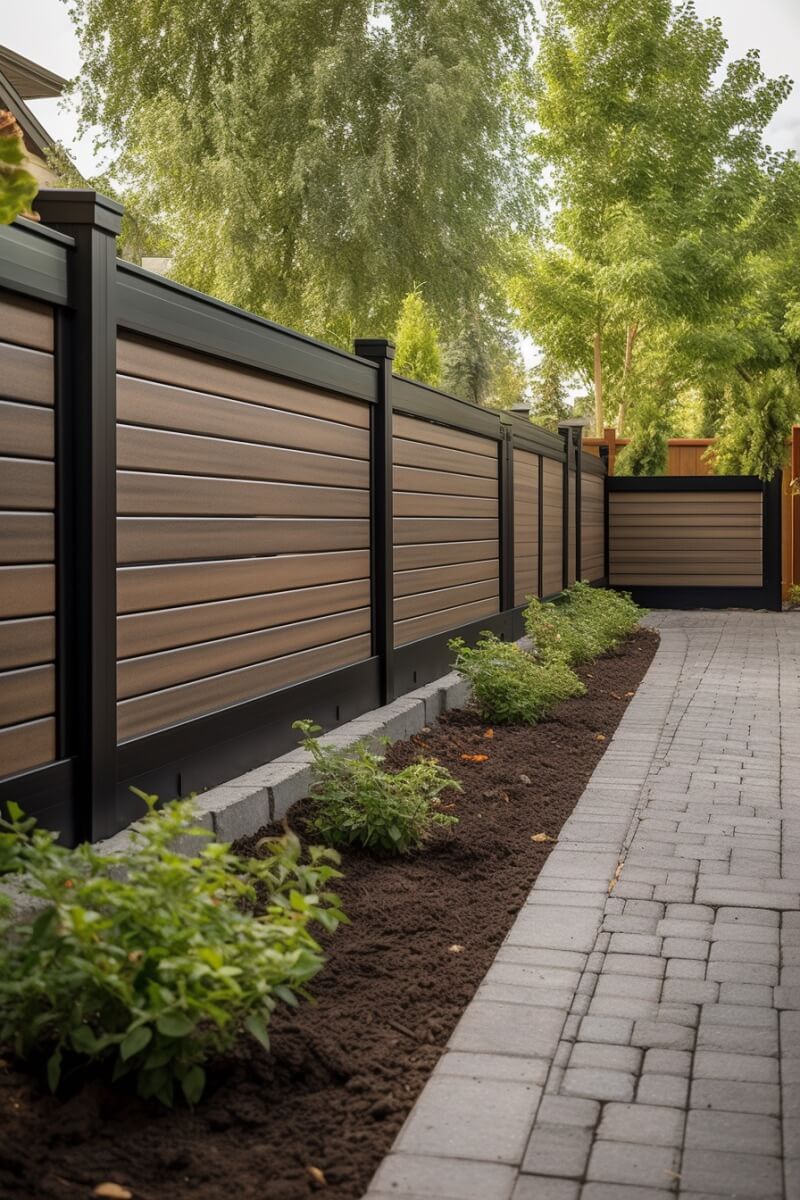
Pros
Cons
10 | Acacia
As a professional carpenter, I can attest that acacia is known for its density and high pliability. This incredibly tough hardwood boasts strong resistance against external elements, making it ideal for structures constantly exposed to water.
Acacia’s attractive grain lends a stunning, warm look to its surroundings, rivaling the appearance of exotic woods. If you’re considering wood for your fencing project, acacia is a beautiful and durable option worth exploring.
| Characteristic | Acacia for Garden Fences |
|---|---|
| Durability | Acacia is highly durable, lasting up to 20-30 years with proper maintenance |
| Hardness | Dense hardwood, offering excellent structural stability and resistance |
| Rot Resistance | Acacia’s natural oils make it highly resistant to rot |
| Insect Resistance | Acacia’s natural oils provide strong resistance to insects |
| Permeability | Low permeability, limiting water absorption and promoting longevity |
| Weight | Acacia is moderately heavy, providing stability |
| Fence Style | Suitable for various styles, such as picket, privacy, and lattice top |
| Finish/Treatment | Staining or sealing optional, Acacia can be left to weather naturally |
| Maintenance | Low maintenance; periodic cleaning and damage checks |
| Cost | Moderately priced, offering a premium look at an affordable cost |
| Sustainability | Acacia is a fast-growing and renewable resource, making it sustainable |
| Harvesting Impact | Properly managed Acacia forests minimize negative impacts on ecosystems |
| Carbon Footprint | Acacia has a relatively low carbon footprint compared to other materials |
Acacia: Mini-Summary & Ideal Fence Type
- Remarkable Durability: Acacia’s high durability ensures a long-lasting fencing solution, with a lifespan of 20-30 years.
- Distinct Fence Styles: Acacia’s unique appearance and workability enable a range of fence designs, such as shadowbox, louver, and post and rail.
- Sustainable Option: Acacia’s fast-growing nature and renewable resource status make it an eco-friendly choice for garden fencing.
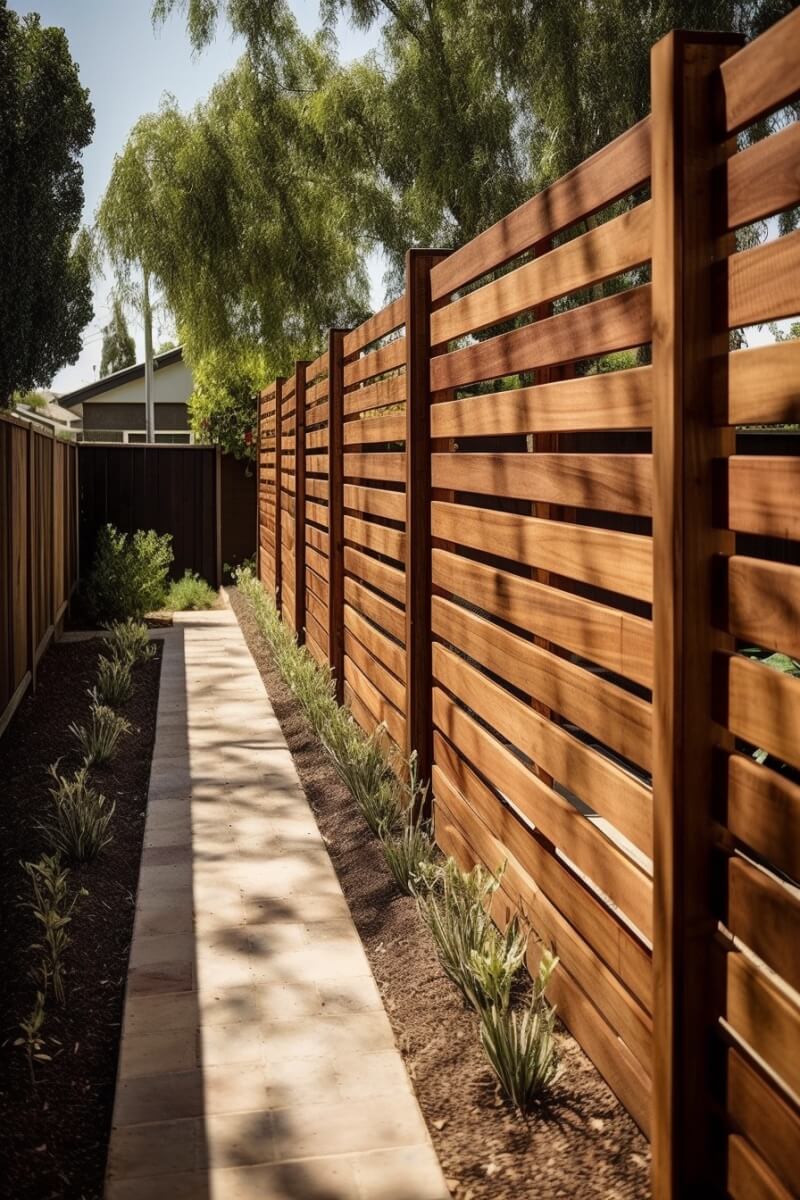
Pros
Cons
The Best Wood for Fence Types For Homeowners
It all comes down to personal choice and factors like budget, local climate, appearance, etc., when choosing a wood type for your fence. Durability is a major deciding issue. In regions with mild climates, you have nothing much to worry about.
However, in regions where the temperatures significantly fluctuate, you have to properly take durability into consideration.
The following is a list of the best wood for various types of fences. Take the list into consideration when planning your next outdoor fencing project.
Horizontal Fence
If your next project involves working on a horizontal fence, go for the ipe wood. This hardwood is ideal for multiple reasons, including its ability to outlast other types of wood. Ipe wood is durable against extreme adverse weather conditions.
The wood also has tightly packed and even grains that offer an aesthetic value. Additionally, it stands strong against twisting and warping. This makes it a perfect choice when constructing a horizontal fence.
A horizontal fence made from ipe wood is an excellent choice due to its durability and resistance to adverse weather. Its tightly packed, even grains provide aesthetic value, and its strength against twisting and warping makes it perfect for horizontal fence construction.
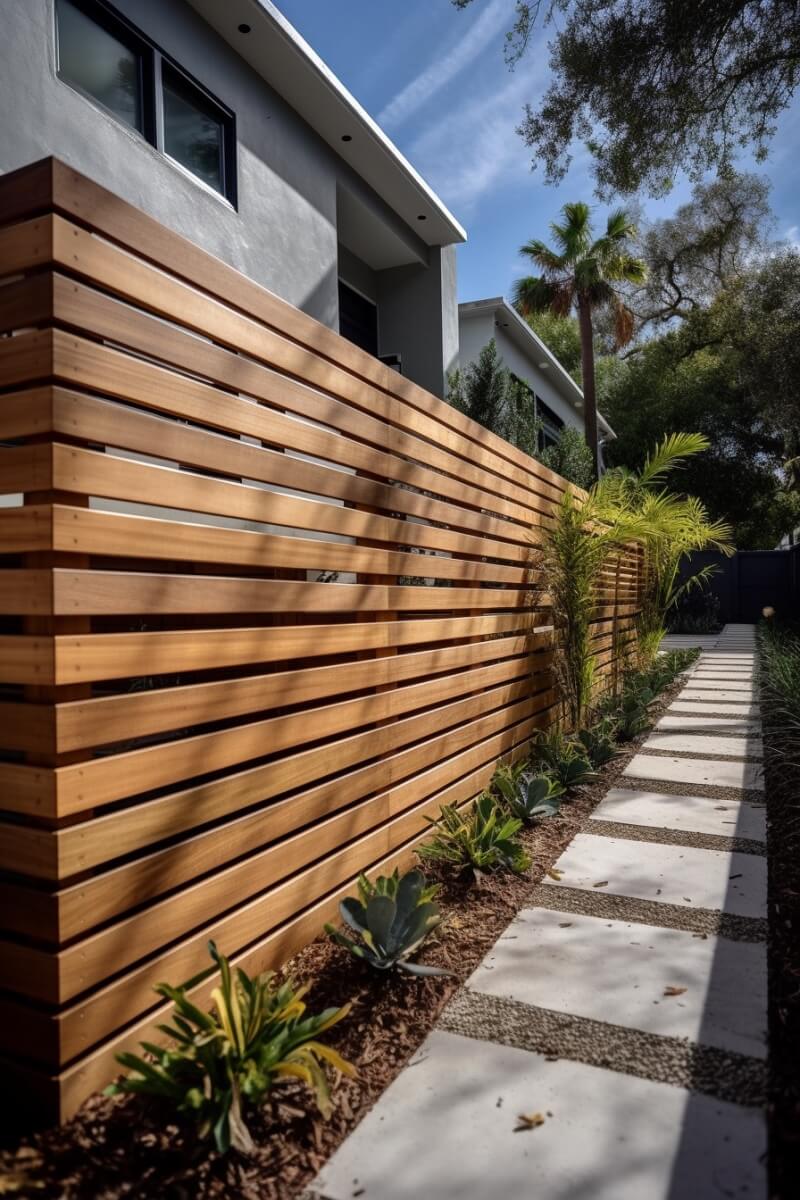
Vertical Fence
The vertical fence is the best type of fence to construct if you are looking to maintain privacy around your property. Such fences are also good to keep away wind during the cold months and protect the interior from noise pollution.
If you are planning on constructing a vertical fence, you should consider redwood. This wood is ideal and quite a popular choice due to the presence of natural oils that repel pests, rot and moisture—without requiring a surface seal.
The redwood has a lengthy lifespan and excellent durability. It does not warp, twist or splinter—all excellent characteristics for a vertical fence.
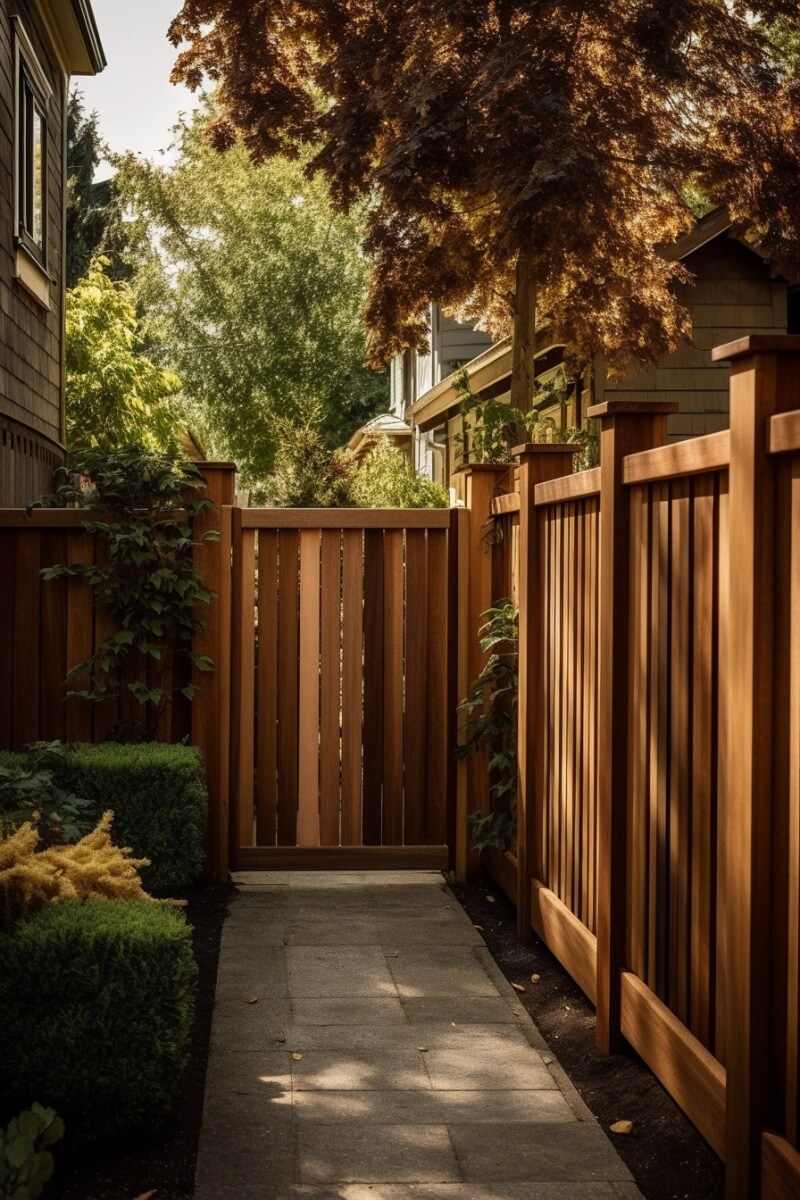
Picket Fence
Picket fences are made up of pointed and wide-spaced pickets. These pickets are usually about three to four feet tall. The height is sufficient to discourage can stragglers from climbing over. Picket fences are great for front yards, gardens and pool enclosures.
Cedar is mostly used for constructing picket fences. Cedar is quite flexible and affordable. With this wood, you do not have to worry about pest or insect infestation as it naturally repels insects. The flexibility of the wood makes it DIY-friendly. When compared to other wood types, cedar is easy to work with.
However, despite its durability, the fence needs to be maintained well. It needs regular cleaning in addition to yearly maintenance for it to retain its best condition. You’ll need to seal your picket fence before you paint the wood to help extend its lifespan.
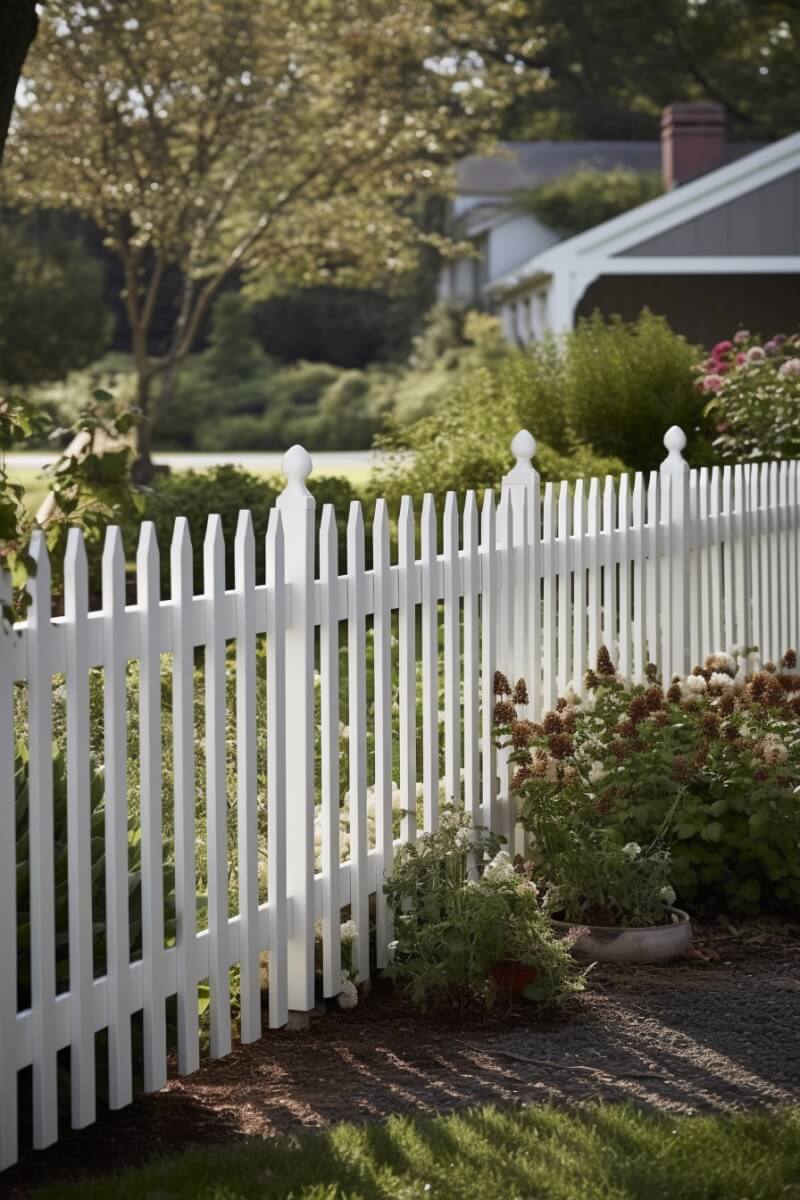
Lattice Fence
In my experience, pressure-treated yellow pine is the most commonly used wood for lattice fences. The treatment process ensures the fence is resistant to both insect and rot damage.
This versatile wood can be stained or painted to match your desired aesthetic. If you prefer to maintain the pine’s original hue, simply seal the wood lattice. However, if left unsealed, exposure to the elements will gradually turn the pine a silver-gray color.
Lattice fences offer a balance of privacy and airflow, ideal for supporting climbing plants. Gardeners’ World Magazine suggests they’re perfect for smaller gardens. Pressure-treated yellow pine ensures longevity and low maintenance.
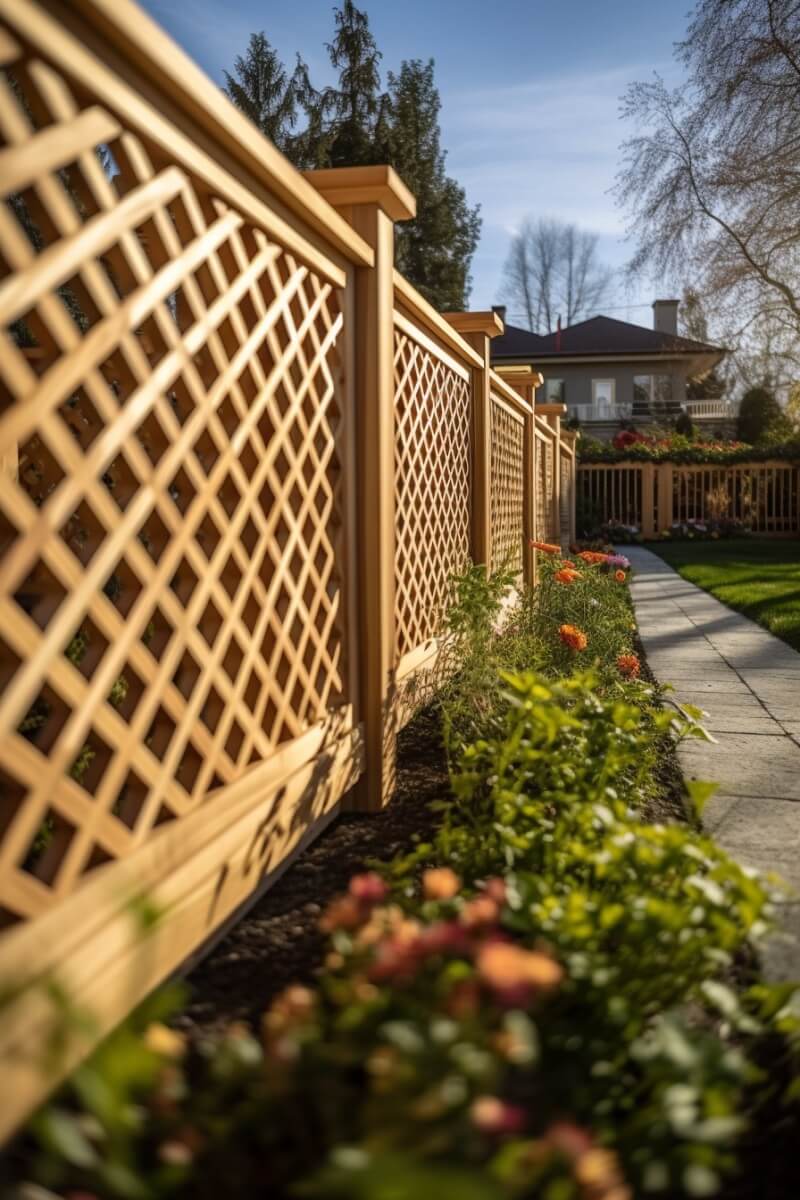
Privacy Fence
A privacy fence serves to protect your property’s privacy, effectively concealing your backyard from prying eyes. These fences typically stand four to six feet tall, providing a secure barrier for children, pets, and backyard amenities such as swimming pools.
Commonly built from composite, vinyl, or wood materials, cedar wood is a popular choice due to its aesthetic appeal, lightweight nature, and durability. Cedar’s uniform, tightly-packed grains offer visual appeal, while its resistance to warping and twisting ensures a long lifespan. Its ease of handling makes cedar an excellent option for DIY privacy fence projects.
In my experience, wood privacy fences not only offer functional benefits but also enhance a property’s overall appearance. Choosing the right wood, such as cedar or redwood, can create a warm, inviting atmosphere while ensuring longevity.
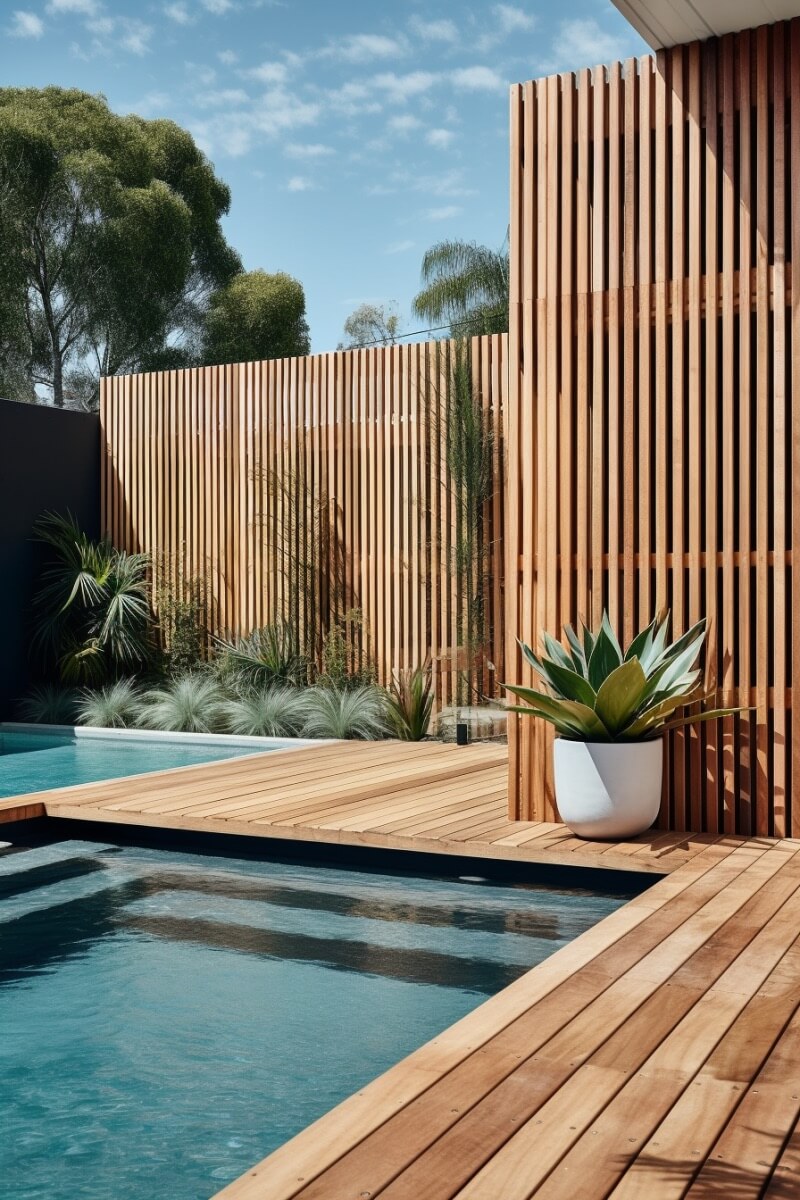
Fence Posts
Any fencing system needs to have a strong backbone. This backbone is the post. Fencing posts support the entire system, which is why they need to be constructed using durable material. They also need to be installed properly.
When choosing wood for fence posts, you should keep a couple of things in mind. First off, wood tends to decay with time. Therefore, it is important to choose a highly durable wood type. Pressure-treated wood help extend the lifespan of the post significantly.
Cedar, redwood and pine are mostly used to build fence posts. They last a long while and provide the necessary backbone to the fencing system.
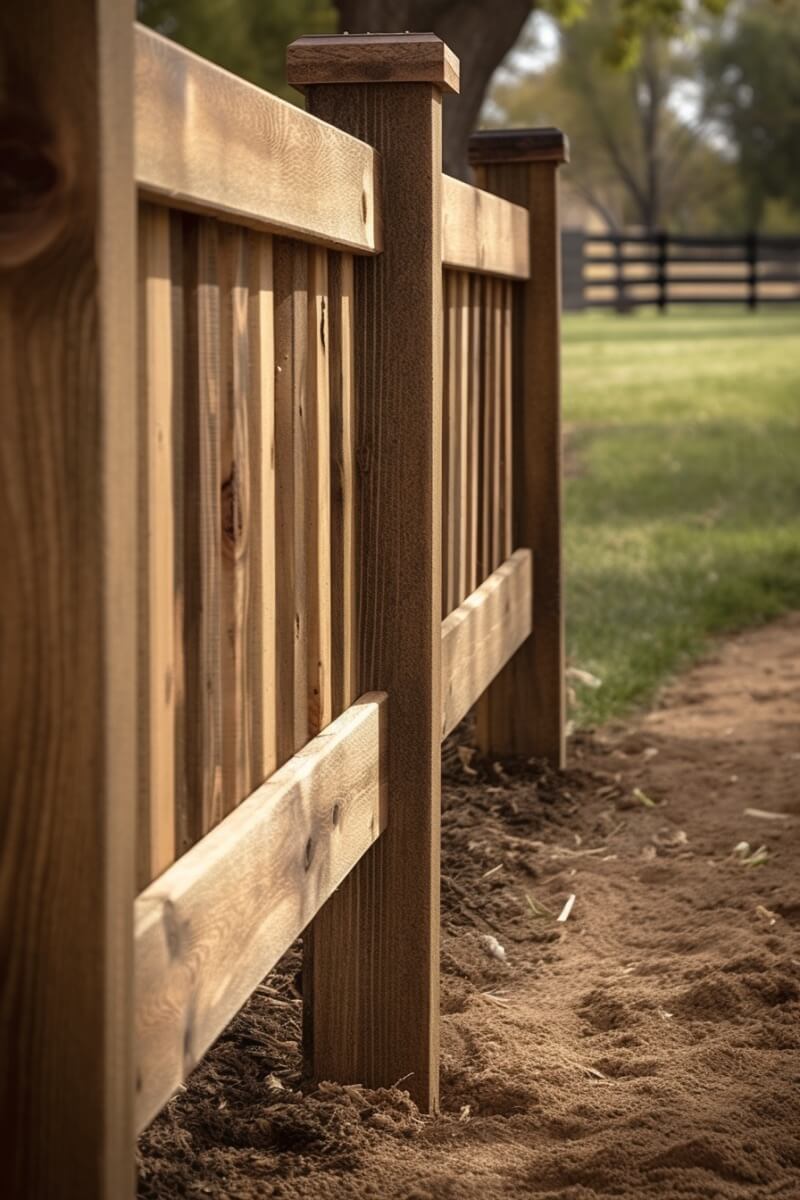
Best Wood for Wooden Fences FAQs.
How to Choose the Best Types of Wood for Fences?
When given the choice to consider a variety of wood types, how do you choose the one that is the best for your construction? There are several important factors to take into account when making this decision. These factors will impact your fence.
While the most commonly used wood types are redwood and cedar, the list is not so narrow. There are many other types of wood to consider. Here are the factors you need to consider during your selection process.
| Wood Type | Durability | Availability | Insect Resistance | Climate Suitability | Budget | Notes |
|---|---|---|---|---|---|---|
| Cedar | High (natural oils resist decay and insects) | High (easily found) | High (naturally repels insects) | Versatile (adapts well) | Moderate | Resistant to decay and insects, requires little maintenance. |
| Redwood | High (dense wood resists decay and warping) | High (widely available) | High (naturally resistant) | Versatile (adapts well) | Expensive | Resistant to decay, insects and warping, but more expensive than Cedar. |
| Cypress | High (resistant to rot and splitting) | Moderate (varies regionally) | High (naturally resistant) | Versatile (adapts well) | Moderate | Rot and insect resistant, less common than Cedar and Redwood. |
| Pine | Moderate (increased when pressure-treated) | High (widely available) | Moderate (pressure-treated resists insects) | Versatile (adapts well) | Affordable | Pressure-treated Pine is resistant to insects and rot, but untreated Pine is vulnerable. |
| Ipe | Very High (extremely dense and hard) | Low (difficult to source) | Very High (naturally repels insects) | Versatile (adapts well) | Expensive | Extremely durable, resistant to insects and rot, but expensive and difficult to source. |
| Douglas Fir | Moderate (needs treatment for rot resistance) | High (widely available) | Moderate (requires treatment) | Versatile (adapts well) | Affordable | Needs to be treated for rot and insect resistance, more affordable option. |
| Balau | High (dense, resistant to wear and decay) | Low (less common) | High (naturally repels insects) | Versatile (adapts well) | Expensive | Durable and insect resistant, but more expensive and harder to source. |
| Maple | Moderate (requires treatment for rot resistance) | High (widely available) | Moderate (requires treatment) | Moderate (best for milder climates) | Moderate | Suitable for milder climates, needs treatment for rot and insect resistance. |
| Composite Wood | High (resistant to decay and insects) | High (widely available) | High (resistant to insects) | Versatile (adapts well) | Expensive | Man-made material, resistant to rot and insects, low maintenance but expensive. |
| Acacia | High (durable and resistant to wear) | Moderate (varies regionally) | High (naturally repels insects) | Versatile (adapts well) | Moderate | Durable and insect resistant, availability varies depending on region. |
Wood Grade
- Durability: Hardwood offers superior durability, longevity, and resistance to insects, rot, and extreme climates compared to softwood.
- Maintenance: Wood grade affects maintenance frequency, including treatment, cleaning, and repairs, impacting the overall cost of ownership.
- Installation: Consider material stability, ground accuracy, and post depth requirements for successful fence installation.
- Quality Grades: Clear and premium grades offer high durability and price, while select and construction grades are more affordable with slight imperfections2.
Availability
- Common Woods: Cedar and redwood are widely available, making them popular choices for fencing projects.
- Rare Woods: Cypress is harder to find, which increases costs and sourcing time for fencing materials.
- Location Impact: Consider local availability when choosing a wood type to minimize time and cost constraints.
- Supply Chain: Rare woods may require additional effort and expense to access, impacting overall project timelines and budgets.
Resistance
- Insect Vulnerability: Some wood types are more susceptible to insect infestation, requiring additional protective measures.
- Natural Resistance: Choose woods like cedar, redwood, or cypress, which naturally repel insects without treatment.
- Pressure-Treated Wood: Opt for pressure-treated wood to increase insect resistance in less naturally resistant wood types.
- Insect-Free Fences: Ensure chosen wood type effectively repels insects to maintain fence longevity and minimize maintenance.
Local Climate
- Weather Impact: Wood type choice is crucial in areas with constant rain or extreme weather patterns to avoid damage.
- Climate-Resistant Wood: Choose wood types capable of withstanding local climate conditions for long-lasting fences.
- Mild Climates: Less durable wood types suffice in regions with milder climate conditions, offering cost savings.
- Extreme Weather: Opt for highly durable wood types in areas with extreme weather patterns to ensure fence longevity.
Budget
- Affordability: Determine your budget and consider wood types within your price range, balancing durability and maintenance costs.
- High-Maintenance Wood: Be aware of future expenses if choosing high-maintenance wood types, which can strain limited budgets.
- Cost-Effective Choices: Select a wood type that offers durability and low maintenance within your budget constraints.
- Investment: Consider both initial purchasing costs and long-term maintenance expenses when selecting a wood type for your fence.
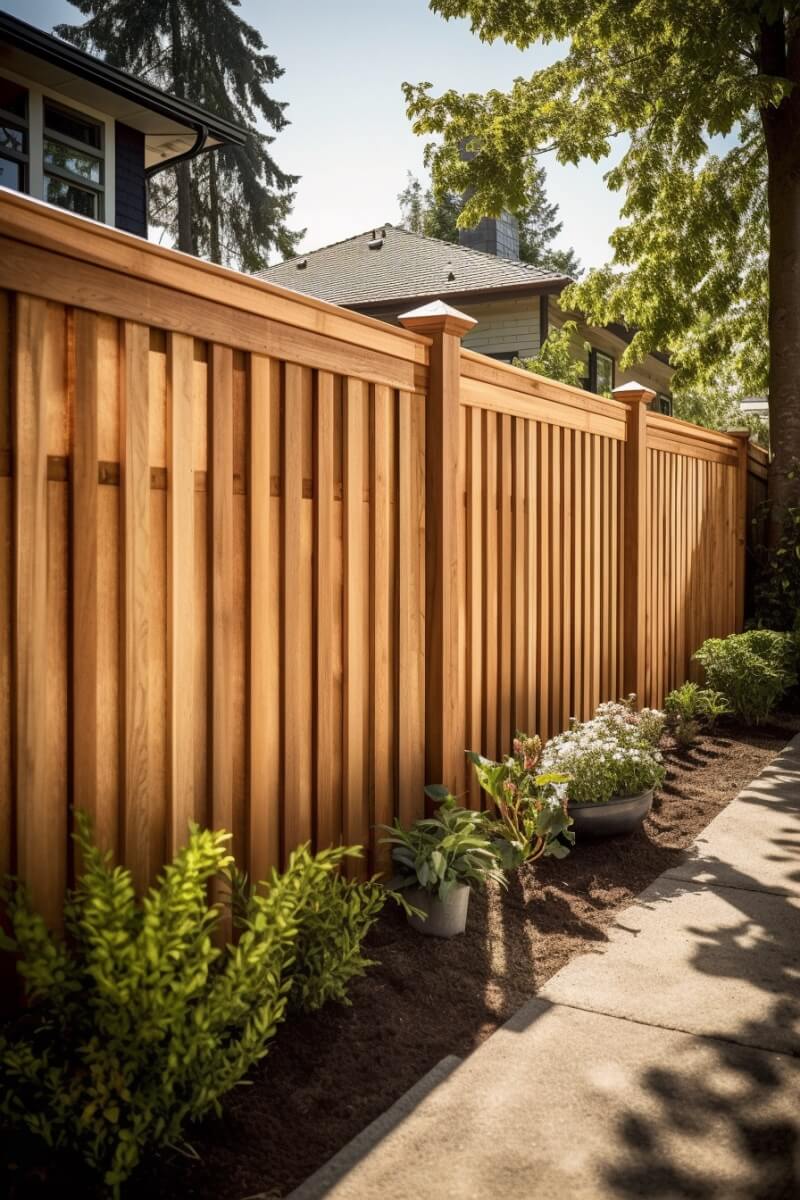
What Type of Fence Has the Least Maintenance?
Choosing a fence type with the least amount of maintenance required will help maintain lower costs. Among this category, treated wood fencing requires overall less maintenance.
Choosing wood for fencing is a popular choice. The scent, look and feel of wood is appealing. However, most homeowners are usually concerned about its maintenance. It does not have to be such a huge worry.
Pressure-treated wood is resistant to extreme climates and insects. When this type of wood is painted and layered with stains or fungicides on a regular basis, it increases its lifespan.
It helps to regularly inspect the wooden fence to stay on top of splintering and cracking issues. Even treated wood requires a keen eye to ensure there is nothing to worry about.
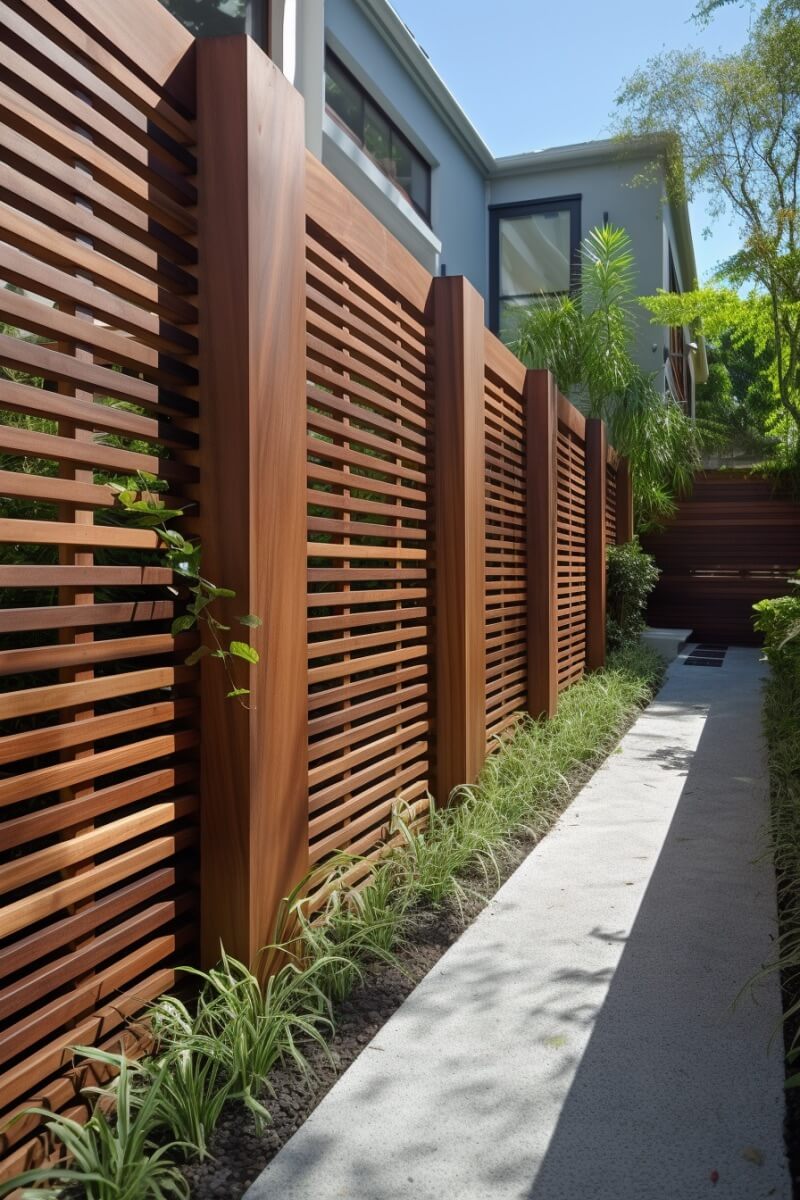
What Type of Wood Fence Is the Best for Privacy?
Security and privacy are the utmost important factors that most homeowners take into consideration when looking to build a fence. No one uses a chain-link fence anymore to keep their property secure.
Nowadays, privacy fences are an increasingly popular choice among those looking to maintain the utmost privacy. These fences are designed to conceal everything from prying eyes while keeping energetic pets and children securely in the enclosed space.
The panels of these fences have no gaps in between, and they tend to be tremendously sturdy. In order to ensure the privacy fence continues to do its work, you will need to keep it in outstanding shape by doing basic maintenance on a regular basis.
The Bottom Line
We hope you enjoyed this comprehensive list of tips to help you choose the best wood for your outdoor fence. By considering factors like wood grade, availability, insect resistance, climate suitability, and budget, you can ensure a durable, low-maintenance, and aesthetically pleasing fence that meets your specific needs.
Applying these tips will not only provide your property with privacy and security, but it will also enhance its overall appearance and value.
If you’re interested in exploring more about wood for outdoor applications, don’t miss our related article on the best wood types for outdoor furniture. This guide will further expand your knowledge and help you create an inviting and comfortable outdoor living space.

